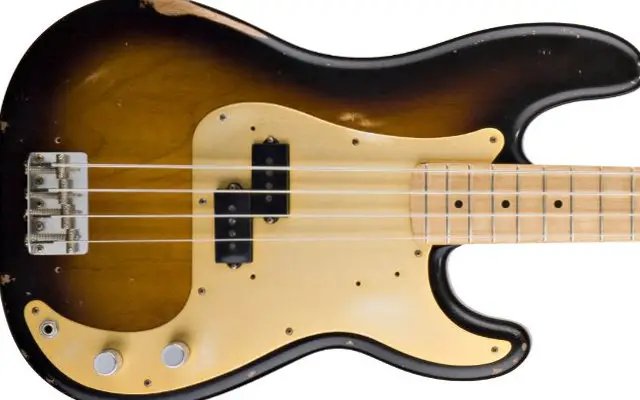When Fender first released the Road Worn bass line, I was both puzzled and fascinated with them.
I had always considered relic basses to be Custom Shop instruments, built by master craftsmen with a high attention to every detail, not stock production models that anyone can pull off the wall.
Of course it was inevitable that one day relic guitars and basses would be mass produced, given their huge surge in popularity over the last few years. The question is…are the Road Worn basses any good?
Fender makes two Road Worn Bass models, the 50’s Precision Bass which closely resembles a 1957 Fender P-Bass and the 60’s Jazz Bass which looks like a 1962-64 Fender Jazz. Color options for both basses are sunburst (2-tone for the P-Bass, 3-tone for the Jazz) and Fiesta Red. The Road Worn series are made in Fender’s Ensenada Factory in Mexico.
The bodies are finished in nitrocellulose lacquer and the necks have a pre-worn polyurethane coat. The necks feature the vintage 7.25″ radius and are C shaped, which I like a lot. The P-Bass has the one piece maple board and the Jazz has the slab rosewood board. The P-Bass sports the classic gold anodized pickguard and the Jazz features the vintage tortoise shell guard. Both basses come with standard vintage pickups, vintage bridges and those very cool, long stem reverse tuners.
The 50’s Precision Bass
I’ve owned an American Vintage ’57 reissue Precision and the Fender Road Worn ’50s Precision Bass sounds very similar, with a deep growl and a nice mid-range bark that really cuts through a mix. The highs were mellow and creamy, just like a vintage P-Bass should sound. The split coil pickup did not have the period correct raised A-pole piece like the ’57 AV RI, which I didn’t mind as I prefer the flush poles anyway.
The bass I played was very light, I would guess around 8.5 lbs at most, and from what I’ve heard this is a pretty common for most Road Worn basses. The lightweight body and thin finish seemed to accentuate the resonance and the notes really blossomed, especially in the middle of the neck. The bass had lots of punch and was real fun to play, I didn’t want to put it down. I especially liked the wide 1 3/4″ nut and flat C-shaped neck.
The sanded down neck felt real comfortable, not unlike many vintage Fenders I’ve played before. The relic finish looked pretty good from a few feet away but up close it did lack the realistic distressing I’ve seen on many Custom Shop basses. Another thing I noticed is that all the Road Worn Basses have the same basic relic pattern on them. It would be nice to see some variations in the relic treatment throughout the line, maybe a light, medium and heavy relic choice, but I guess you can only expect so much from a production bass.
The build quality was excellent on this bass. It felt very much like a U.S. Vintage series bass and everything was real solid and well put together. Overall I was very impressed with this bass, I’ve played a few real vintage Precisions over the years and the Road Worn P-Bass comes pretty close to nailing that feel and vibe.
The 60’s Jazz Bass
The Fender Road Worn ’60s Jazz Bass has that similar broken in feel of the P-Bass. The thin neck (1 1/2″ at the nut) is fast but has a little more meat on it than the ’62 American Vintage Reissue Jazz and I like that. The pickups have that classic focused, sweet tone that has made the Jazz one of the most beloved instruments of all time. The lows are full and tight and the highs sing beautifully, a great sounding J-Bass.
Like all Jazz Basses with single coil pickups they are subseptiable to hum when both volumes are not all the way up. I personally prefer the neck pickup only sound, which produces that distinct deep, woody bark. But the combination of the two pickups can cover a lot of ground. With both turned on full the tone was rich and smooth, just like a vintage Jazz should sound. This Bass can handle pretty much any musical situation, and sound great doing it.
The relic pattern is very similar to the Precision as are all the Road Worn Basses, and although it might be nick-picky I wasn’t that impressed with the tortoise shell pickguard…the pattern looked flat and too swirly compared to the deep and rich real vintage tort. guards. The Bass was pretty light, just slightly heavier than the P-Bass and was real comfortable on my lap. The overall quality was excellent and the bass was as solid and well made as any American made Jazz I’ve played.


IMHO the RW 50s P is as good in looks,sound, feel and playability as any non-CS US-built bass. I’ve owned several US basses- all very good instruments, but the RW has a playing feel that non-CS US and standard MIMs are missing. The RW sounds amazing, as good as any P-Bass. The relicing looks great too (mine’s a ‘10 2TSB). Disregard the MX serial number… do you look to see where your amp/pedals are made?